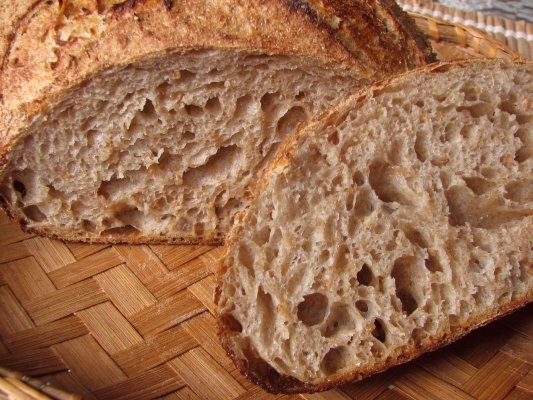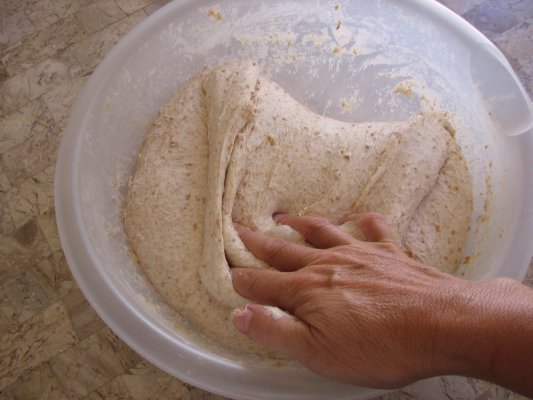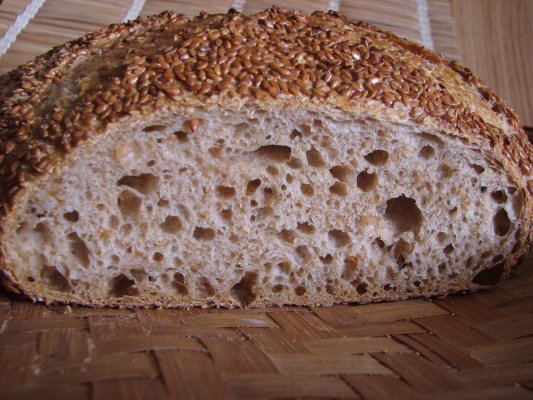Flaxseed Loaf and Kneading in a Bowl
I have a new recipe for you… Flaxseed Loaf. This bread was lots of fun to bake. I made up two variations, a plain loaf and a loaf covered with flaxseeds. They were both really good. Here is the recipe;
Flaxseed Loaf:
.
(You are only going to need a very small piece of “old dough” to ferment this dough- if you only have regular starter at 100% hydration and would like to make a piece of “old dough” – In the morning take 1 oz of your 100% starter and stir in .5 oz of water and 1 oz of flour and let set, covered before using that same night, this will give you more than you need but take what you need and discard the rest.It also won’t be exactly the right hydration, but the amount is so small it doesn’t make a lot of difference.)
.
Mix up the following to make a preferment the night before you want to bake :
- 1 cup ground whole wheat berries – grind them coarse or use cracked wheat -6.5 oz/184g (if you use pre-cracked wheat, go by the weight as it will be more than a cup)
- 1/4 cup flax seeds-ground coarse- 1.5 oz/42g ( I use a small cheap coffee grinder)
- Whole wheat “old dough” a piece of 65% hydration dough left over from the last batch of bread you made or a piece of starter that is at 65% hydration -1.5 oz/42g
- 2 cups of water-16 oz/453g
- 1 teaspoon salt- .2 oz/5g
- 1 cup whole wheat flour-4.2 oz/119g
Stir all of the above ingredients in a large bowl and cover, let it set overnight at room temperature. This will give the starter time to multiply and break down the indigestible portions of the whole wheat grains. You will have approximately 1 lb 13 oz/ 847g of preferment at 137.6 % hydration.
Next morning, add to your bowl of preferment :
- 1 and 1/4 cups of water – 11 oz/311.9g
- 6.5 cups Bread flour- I used Stone Buhr Bread flour- 29.3 oz/830g
- 1 Tablespoon salt- .6 oz/17g
Mix all of the above ingredients together and let the dough set for 1/2 hour. Even though this isn’t a true autolyse, because the salt was already added, it still allows the gluten time to absorb the water and relax.
.
After the resting period, take your soft dough and knead it in the bowl for five minutes. Here are a few pictures to show you how that is done:
.
Pull up the dough and stretch it gently:
.
.
Fold the dough over on top of the rest of the dough:
.
Using your other hand, turn the bowl a quarter turn and then pull up and stretch another piece of the dough:
.
.
Fold the dough over again on top of itself and then turn the bowl a quarter turn again:
.
.
Continue stretching, folding, and turning the bowl a quarter turn. Get a rythm going, it is easy and fun. This kind of kneading helps you to keep the extra flour out of the dough that you would normally use to keep it from sticking to the surface. You also don’t have to worry about scraping it off the surface when your done.
.
This is the consistancy of the dough once it has been kneaded in the bowl, it is at 67% hydration:
.
We are doing a bit of kneading here because even though you have a preferment, the bulk of the flour was added on the day of the bake, which means it really didn’t get much time to ferment and develop it’s gluten like you would with a no-knead dough.
Allow the dough to ferment four hours at 80F/27C . If you don’t have an area that warm, you might have to let the dough ferment longer. After the bulk ferment is done, divide the dough in half and do a preliminary shaping of the dough into boules.
.
I do one loaf at a time and space the shaping 30 minutes apart so the loaves are staggered for baking. Allow the dough to rest five minutes and then do a final shaping of the dough. Place the boule upside down into a banneton or linen lined basket which has been sprinkled with whole wheat flour or semolina flour.
.
If you desire the loaf to be coated with flax seeds, sprinkle a layer of seeds on your surface and roll the wettish dough around coating the surface of the dough, then sprinkle some seeds in your basket as well before you place your dough inside.
.
Allow the dough to raise to about 1.5 times it’s original size, taking usually two to three hours. Have prepared a very hot oven of 500F/260C making sure your stone is hot all the way through and the roasting lid or domed lid is also hot.
.
Put the loaf onto your semolina sprinkled baking peel by turning your banneton or basket upside down and supporting the loaf with your hand. Slash the dough as desired.
.
Place your loaf onto the hot stone and working quickly, spray the whole surface of the dough with water. Then place the hot roasting lid over the dough , close the oven and set your timer for 20 minutes.
.
After 20 minutes, take off the roasting lid carefully with thick oven mitts as the oven is VERY hot. Turn the oven down to 450F/232C.
.
Bake for 10 – 15 minutes more. Take your loaf out when it is a nice deep color and sounds hollow when thumped on the bottom.
.
I had trouble with my first loaf, which was the loaf covered with seeds, the propane ran out so it didn’t get as good of an oven spring, but it still turned out okay. The crust was a little thicker because of the oven not being hot enough as well. You can definately see the difference when the oven was hot enough for the second loaf:
.
.
.
Here is the second loaf:
.
.
.
This bread has a wonderful nutty taste and aroma, it stays fresh several days from the addition of the flaxseeds. It also toasts up great. I will be sending these loaves to be guests at Yeastspotting, on Susan’s terrific blog, Wild Yeast.














